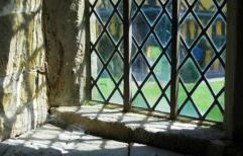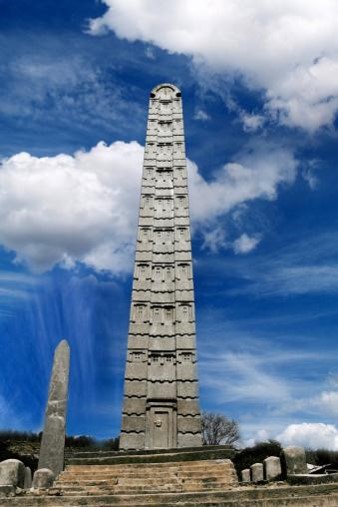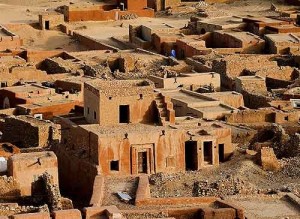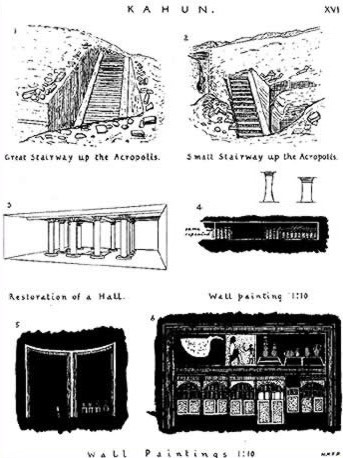Advanced Architecture Engineering and Building
 The ancient architecture of Africa, like everything else about this continent is of such a wide variety and is so diverse its amazing. Throughout the history of Africa, Africans have had their own architectural traditions. Everything from the Great Pyramids in the north to the Great Wall of Zimbabwe in the south – its an amazing testimony
The ancient architecture of Africa, like everything else about this continent is of such a wide variety and is so diverse its amazing. Throughout the history of Africa, Africans have had their own architectural traditions. Everything from the Great Pyramids in the north to the Great Wall of Zimbabwe in the south – its an amazing testimony
Check out the amazing structures below.
Great Wall of Nigeria
- Nigeria’s rain forest a suspected centre of one of Africa’s greatest kingdoms
Scientists from Bournemouth University, working with archaeologist Dr. Patrick Darling - a wall and ditch measuring 14 metres high and about 160 kilometres long.
earthworks must have moved an estimated 3.5 million cubic metres of earth to build the ramparts
- one million cubic metres more than the amount of rock and earth which went into building the Great Pyramid of Cheops in Egypt
believed to be the boundary of the original Ijebu Kingdom ruled by the Awujale - “The vertical sided ditches go around the area for 100miles (160km), and its more than 1,000 years old. That makes it the earliest proof of a kingdom founded in the African rain forest”
- The mediaeval Nigerian city of Benin was built to “a scale comparable with the Great Wall of China”.
- There was a vast system of defensive walling totalling 10,000 miles in all.
Quick facts:
- The Benin walls consisted of a combination of ramparts and moats.
- The ramparts ranged in size from shallow traces to gigantic 20-meter-high (66 feet) around Benin City.
- It covered a border distance of 16,000km.
- It enclosed 6500km² of community land.
- Its construction is estimated to have started as early as 800AD.
- It was finally completed around 1460AD.
- It provided a defensive barrier against invaders.
- Shortly after the wall and the ditch were completed, the Portuguese visited Benin in 1472 AD.
- At that time, it was considered the world’s largest earthwork. European visitors travel notes described the Great wall of Benin e.g. Dapper 1668.
- The Guinness Book of World Records (1974) describes the walls of Benin City as the world’s second largest man-made structure after China’s Great Wall,
- in terms of length, and the series of earthen ramparts as the most extensive earthwork in the world.
- Fred Pearce wrote in New Scientist:

They extend for some 16,000 kilometres in all, in a mosaic of more than 500 interconnected settlement boundaries. They cover 6,500 square kilometres and were all dug by the Edo people. In all, they are four times longer than the Great Wall of China, and consumed a hundred times more material than the Great Pyramid of Cheops. They took an estimated 150 million hours of digging to construct, and are perhaps the largest single archaeological phenomenon on the planet.
Here is a view of Benin city in 1891 before the British conquest. H. Ling Roth, Great Benin, Barnes and Noble reprint. 1968

Ancient Nigerian/Benin Cities
- “By the year A.D. 1300,” says a modern scholar, “the Yoruba people built numerous walled cities surrounded by farms”. The cities were Owu, Oyo, Ijebu, Ijesa, Ketu, Popo, Egba, Sabe, Dassa, Egbado, Igbomina, the sixteen Ekiti principalities, Owo and Ondo.
- West Africa had walled towns and cities in the pre-colonial period. Winwood Reade, an English historian visited West Africa in the nineteenth century and commented that:
- “There are … thousands of large walled cities resembling those of Europe in the Middle Ages, or of ancient Greece.”
Kano -Nigeria
- Lord Lugard, an English official, estimated in 1904 that there were
- 170 walled towns still in existence in the whole of just the Kano province of northern Nigeria.
- The royal palace in the city of Kano dates back to the fifteenth century. It was started by Muhammad Rumfa (ruled 1463-99) it over the years it grew gradually into a vast intricate complex.
- “a network of buildings covering an area of 33 acres and surrounded by a wall 20 to 30 feet high outside and 15 feet inside … in itself no mean citadel”
- In 1851 Kano was producing an estimated 10 million pairs of sandals and 5 million hides each year for export. A colonial report of the city from 1902, described it as
Architecture – Asante Empire
- “A well-built castle, thoroughly fortified, decorated inside with sculptures and pictures, and having glass windows.”
- “Kumasi was the capital of the Asante Kingdom, 10th century-20th century. Drawings of life in Kumasi show homes, often of 2 stories, square buildings with thatched roofs, with family compounds arranged around a courtyard. The Manhyia Palace complex drawn in another sketch was similar to a Norman castle, only more elegant in its architecture.
- “The townhouses of Kumase had upstairs toilets in 1817.This city in the 1800s is documented in drawings and photographs. Promenades and public squares, cosmopolitan lives, exquisite architecture and everywhere spotless and ordered, a wealth of architecture, history, prosperity and extremely modern living” – PD Lawton, AfricanAgenda.net
- “These 2 story thatched homes of the Ashanti Kingdom were timber framed and the walls were of lath and plaster construction. A tree always stood in the courtyard which was the central point of a family compound. The Tree of Life was the altar for family offerings to God, Nyame. A brass pan sat in the branches of the tree into which offerings were placed. This was the same in every courtyard of every household, temple and palace. The King`s representatives, officials, worked in open-sided buildings. The purpose being that everyone was welcome to see what they were up to.
- A Moorish nobleman who lived in Spain by the name of Al-Bakri questioned merchants who visited the Ghana Empire in the 11th century and wrote this about the king:
- “He sits in audience or to hear grievances against officials in a domed pavilion around which stand ten horses covered with gold-embroidered materials. Behind the king stand ten pages holding shields and swords decorated with gold, and on his right are the sons of the kings of his country wearing splendid garments and their hair plaited with gold. The governor of the city sits on the ground before the king and around him are ministers seated likewise. At the door of the pavilion are dogs of excellent pedigree that hardly ever leave the place where the king is, guarding him. Around their necks they wear collars of gold and silver studded with a number of balls of the same metals” – p.80 de Corpus of Early Arabic Sources for West Africa por Nehemia Levtzion e John F.P. Hopkins.
- “We went to the king’s palace, which consists of many courtyards, each surrounded with alcoves and verandahs, and having two gates or doors, so that each yard was a thoroughfare … But the part of the palace fronting the street was a stone house, Moorish in its style … with a flat roof and a parapet, and suites of apartments on the first floor. It was built by Fanti masons many years ago. The rooms upstairs remind me of Wardour Street. Each was a perfect Old Curiosity Shop. Books in many languages, Bohemian glass, clocks, silver plate, old furniture, Persian rugs, Kidderminster carpets, pictures and engravings, numberless chests and coffers. A sword bearing the inscriptionFrom Queen Victoria to the King of Ashantee. A copy of the Times, 17 October 1843. With these were many specimens of Moorish and Ashanti handicraft.”
- The beautiful city of Kumasi was blown up, destroyed by fire, and looted by the British at the end of the 19th century. Here below are few depictions of the city.

Kumbi Saleh
Kumbi Saleh, the capital of Ancient Ghana, flourished from 300 to 1240 AD. Located in modern day Mauritania, archaeological excavations have revealed houses, almost habitable today, and all they need are just a little renovation/TLC and they’re several storeys high. They had underground rooms, staircases and connecting halls. Some had nine rooms. One part of the city alone is estimated to have housed 30,000 people.
Mali – Mauritania
- By 250 BC, the foundations of West Africa’s oldest cities were established such as Old Djenné in Mali.
- One of the world’s ancient and beautiful empires. Full of culture and art and science and just general beauty. In a land now ravaged by war and ever encroaching desert, there is still tons of evidence of just how advanced these cultures were.
- The Grand Mosque in the Malian city of Djenné, described as “the largest adobe [clay] building in the world”, was first raised in 1204 AD. It was built on a square plan where each side is 56 metres in length. It has three large towers on one side, each with projecting wooden buttresses.
West Africans built in stone too, not just adobe, by 1100 BC. In the Tichitt-Walata region of Mauritania, archaeologists have found “large stone masonry villages” that date back to 1100 BC. The villages are built as large roughly circular compounds connected by “well-defined streets”.
 Excavations at the Malian city of Gao carried out by Cambridge University revealed glass windows. One of the finds was entitled: “Fragments of alabaster window surrounds and a piece of pink window glass, Gao 10th – 14th century.”
Excavations at the Malian city of Gao carried out by Cambridge University revealed glass windows. One of the finds was entitled: “Fragments of alabaster window surrounds and a piece of pink window glass, Gao 10th – 14th century.”
- The old Malian capital of Niani had a 14th century building called the Hall of Audience. It was an surmounted by a dome, adorned with arabesques of striking colours. The windows of an upper floor were plated with wood and framed in silver; those of a lower floor were plated with wood, framed in gold.
- Italian art and architecture scholar Sergio Domian noted the incredible work that has been discovered in Mali, explaining that Mali had
- “laid the foundation” for an urban civilization.” “At the height of its power, Mali had at least 400 cities and the interior of the Niger Delta was very densely populated,” Domian wrote.
Chad (Kanem-Borno)
- Ngazargamu, the capital city of Kanem-Borno, became one of the largest cities in the seventeenth century world
- By 1658 AD, the metropolis, according to an architectural scholar housed “about quarter of a million people”. It had 660 streets. Many were wide and unbending, reflective of town planning.
Kenya – Gedi

- Gedi, near the coast of Kenya, is one of the East African ghost towns. Its ruins, dating from the fourteenth or fifteenth centuries, include the city walls, the palace, private houses, the Great Mosque, seven smaller mosques, and three pillar tombs.
- And on top of that, check this out the ruined mosque in the city had a water purifier made of limestone for recycling water. The contains evidence of piped water controlled by taps. TAPS!!
Tanzania – Kilwa
- visitor in 1331 AD considered the Tanzanian city of Kilwa to be of world class. He wrote that it was the
 “principal city on the coast the greater part of whose inhabitants are Zanj of very black complexion.” Later on he says that: “Kilwa is one of the most beautiful and well-constructed cities in the world. The whole of its elegantly built.”
“principal city on the coast the greater part of whose inhabitants are Zanj of very black complexion.” Later on he says that: “Kilwa is one of the most beautiful and well-constructed cities in the world. The whole of its elegantly built.”- The picture below shows an artist’s reconstruction of the sultan’s palace in Kilwa in the 1400’s, followed by other ruins photographs.
- The picture shows an artist’s reconstruction of the sultan’s palace in Kilwa in the 1400’s, followed by other ruins photographs.
- In 1961 a British archaeologist, found the ruins of Husuni Kubwa, the royal palace of the Tanzanian city of Kilwa. It had over a 100 rooms, including a reception hall, galleries, courtyards, terraces and an octagonal swimming pool
- Again, is this the Darwinian Africa they teach in class or textbooks. A Portuguese historian of the sixteenth century wrote that:
- [T]hey are finely clad in many rich garments of gold and silk and cotton, and the women as well; also with much gold and silver chains and bracelets, which they wear on their legs and arms, and many jewelled earrings in their ears”.
Ethiopia – Axum
 The Ethiopian city of Axum has a series of 7 giant obelisks that date from perhaps 300 BC to 300 AD. They have details carved into them that represent windows and doorways of several storeys. The largest obelisk, now fallen, is in fact “the largest monolith ever made anywhere in the world”. Its 108 feet long, weighs a staggering 500 tons, and represents a thirteen-storey building. Yup…in the world.
The Ethiopian city of Axum has a series of 7 giant obelisks that date from perhaps 300 BC to 300 AD. They have details carved into them that represent windows and doorways of several storeys. The largest obelisk, now fallen, is in fact “the largest monolith ever made anywhere in the world”. Its 108 feet long, weighs a staggering 500 tons, and represents a thirteen-storey building. Yup…in the world.- Aksum’s Giant Stelae (Ethiopia) – The ruins of the ancient city of Aksum are located close to Ethiopia’s northern border. They mark the location of the heart of ancient Ethiopia, when the Kingdom of Aksum was the most powerful state between the Eastern Roman Empire and Persia.
- The massive ruins, dating from between the first and 13th centuries, include monolithic obelisks, giant stelae, royal tombs and the ruins of ancient castles. These obelisks, also called stelae, are known to be the tallest single pieces of stone ever quarried and erected in the ancient world.
Empire of Kush (Sudan, Ethiopia, Eritrea, Somalia)
- Glass windows also existed in mediaeval Sudan. Archaeologists found evidence of window glass at the Sudanese cities of Old Dongola and Hambukol.
- Sudan in the 9th century AD had housing complexes with bath rooms and piped water. An archaeologist wrote that Old Dongola, the capital of Makuria, had:
- “a[n] … eighth to … ninth century housing complex. The houses discovered here differ in their hitherto unencountered spatial layout as well as their functional programme (water supply installation, bathroom with heating system) and interiors decorated with murals.”
- Not many people know that there are also pyramids build by an ancient empire south of Egpyt. A Nubian empire with distinctly Nubian culture and features competing with that of Egypt in richness and in lifespan and history. Prior to the Kushites building these pyramids, there had been no pyramid construction in Egypt and the Nile Valley for more than 500 years. The area of the Nile valley known as Nubia, which lies within present day Sudan, was home to three Kushite kingdoms during antiquity.
Nubia and the Kushite Empire – “bane of Pharoah”

- The first had its capital at Kerma(2600–1520 BC). The second was centered on Napata (1000–300 BC). Finally, the last kingdom was centered on Meroë(300 BC–AD 300).
 Wide view of Nubian pyramids, Meroe. Three of these pyramids are reconstructed.
Wide view of Nubian pyramids, Meroe. Three of these pyramids are reconstructed.- Not many people know that there are also pyramids build by an ancient empire south of Egpyt. A Nubian empire with distinctly Nubian culture and features competing with that of Egypt in richness and in lifespan and history. Prior to the Kushites building these pyramids, there had been no pyramid construction in Egypt and the Nile Valley for more than 500 years. The area of the Nile valley known as Nubia, which lies within present day Sudan, was home to three Kushite kingdoms during antiquity.
- The first had its capital at Kerma(2600–1520 BC). The second was centered on Napata (1000–300 BC). Finally, the last kingdom was centered on Meroë(300 BC–AD 300).
 25th Dynasty royal monumental statues from Doukki-Gel
25th Dynasty royal monumental statues from Doukki-Gel- The known rulers, in the History of Egypt, for the twenty-fifth dynasty are the following:
Dynasty XXV pharaohs Pharaoh Throne Name Reign (BC) Kashta Maatre c. 760 BC – c. 752 BC Piye Menkheperre Usermaatre c. 752 BC – 721 BC Shabaka Neferkare 721 BC – 707 BC Shebitku Djedkare 707 BC – 690 BC Taharqa Khunefertumre 690 – 664 BC Tantamani Bakare 664 – 656 BC (died 653 BC)
 The period starting with Kashta and ending with Malonaqen is sometimes called the Napatan Period. The later Kings from the twenty-fifth dynasty ruled over Napata, Meroe, and Egypt. The seat of government and the royal palace were in Napata during this period, while Meroe was a provincial city.
The period starting with Kashta and ending with Malonaqen is sometimes called the Napatan Period. The later Kings from the twenty-fifth dynasty ruled over Napata, Meroe, and Egypt. The seat of government and the royal palace were in Napata during this period, while Meroe was a provincial city.
 The kings and queens were buried in El-Kurru and Nuri. Although the Twenty-Fifth Dynasty controlled Ancient Egypt for only 89 years (from 760 BC to 671 BC), it holds an important place in Egyptian history due to the restoration of traditional Egyptian values, culture, art, and architecture.
The kings and queens were buried in El-Kurru and Nuri. Although the Twenty-Fifth Dynasty controlled Ancient Egypt for only 89 years (from 760 BC to 671 BC), it holds an important place in Egyptian history due to the restoration of traditional Egyptian values, culture, art, and architecture.
- The 25th dynasty likely influenced Greek visitors. Herodotus wrote that the Aethiopians (Greek and Assyrian-Babylonian name for Kush) may have been the most ancient people on Earth and that Egypt was founded from Ethiopia. Herodotus also posited that the Greek gods originated in Ethiopia (e.g. Homer’s references to the gods going to Ethiopia to convene).
Walls of Great Zimbabwe (Masvingo, Zimbabwe)

- Great Zimbabwe was an ancient city in the southeastern hills near the town of Masvingo.
- It was the capital of the Kingdom of Zimbabwe during the country’s Late Iron Age, and served as a royal palace and the seat of political power for the Zimbabwean monarch.
- One of its most prominent, enduring and impressive features are its stone walls, some of which were over 36 feet high extending over long serpentine courses. The magnificent structures with remarkably finished surfaces were constructed by stacking granite stones, one on top of another, without mortar.
- The ancestors of the Shona people started the construction of these great walls in the 11th century and they didn’t finish until the 14th century, covering a total area of 722 hectares (1,780 acres) which, at its peak, could have housed up to 18,000 people.
- In the 1800s, European travelers and English colonizers, stunned by Great Zimbabwe’s grandeur and workmanship, attributed the architecture to foreign powers. Yup, no way these backward…ape-like (Darwinian) people could have built something so beautiful and so architecturally advanced.

- Well later on when objective research was done, these comments were dismissed when investigations conducted recently in this 20th century confirmed both the antiquity of the site and its African origins
- The Great Zimbabwe was the largest of these ruins. It consists of 12 clusters of buildings, spread over 3 square miles. Its outer walls were made from 100,000rom 100,000
English: World English Bible - WEB
301 Moved Permanently Moved Permanently The document has moved .
WP-Bible plugin tons of granite bricks. In the fourteenth century, the city housed 18,000 people, comparable in size to that of London of the same period. - part from Great Zimbabwe, there are at least 600 stone built ruins in the regions of Zimbabwe, Mozambique and South Africa. These ruins are called Mazimbabwe in Shona, the Bantu language of the builders, and means great revered house and “signifies court”.
Monomotapa / Mutapa
- The Kingdom of Mutapa, sometimes referred to as the Mutapa Empire was a Shona kingdom which stretched between the Zambezi and Limpopo rivers of southern Africa in the modern states of Zimbabwe and Mozambique.
- Description of the Monomotapan royal palace at Mount Fura. It had chandeliers hanging from the ceiling. Plush decorations and furniture.
Egypt – thinks you didn’t know
- Egyptian mansions were discovered in Kahun – each had like 70 rooms! There was a master’s quarter, quarters for women and servants, quarters for offices and finally, quarters for granaries, each facing a central courtyard. Wow…imagine how beautiful that was. The master’s quarters had an open court with a stone water tank for bathing. Surrounding this was a colonnade.
- The Labyrinth in the Egyptian city of Hawara with its massive layout, multiple courtyards, chambers and halls, was the very largest building in antiquity. Boasting three thousand rooms, 1,500 of them were above ground and the other 1,500 were underground.
- Toilets and sewerage systems existed in ancient Egypt. One of the pharaohs built a city now known as Amarna. An American urban planner noted that: “Great importance was attached to cleanliness in Amarna as in other Egyptian cities. Toilets and sewers were in use to dispose waste. Soap was made for washing the body. Perfumes and essences were popular against body odour. A solution of natron was used to keep insects from houses … Amarna may have been the first planned ‘garden city’.”
















